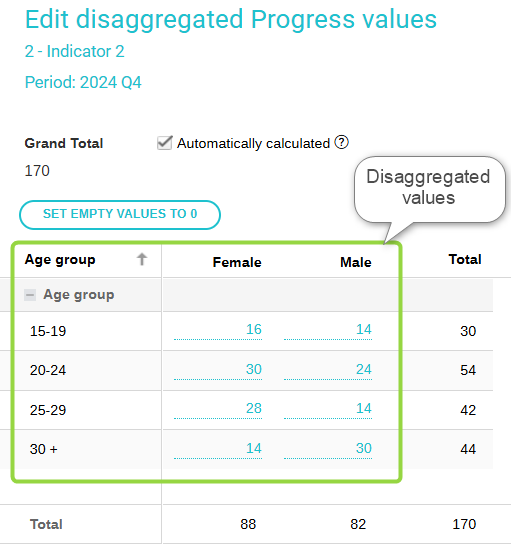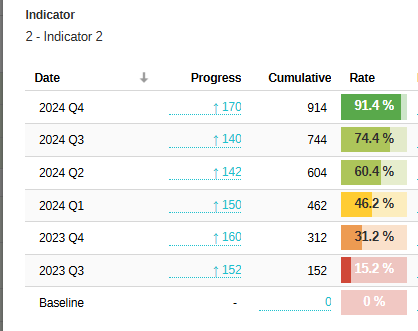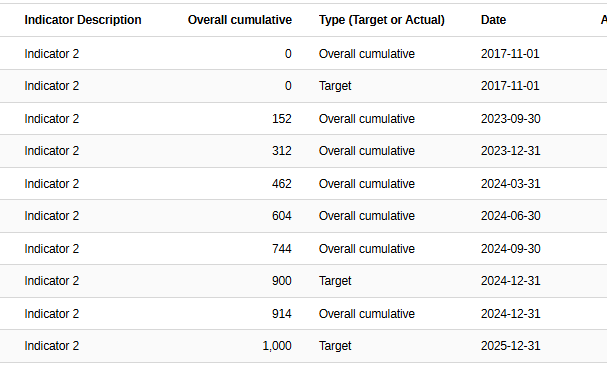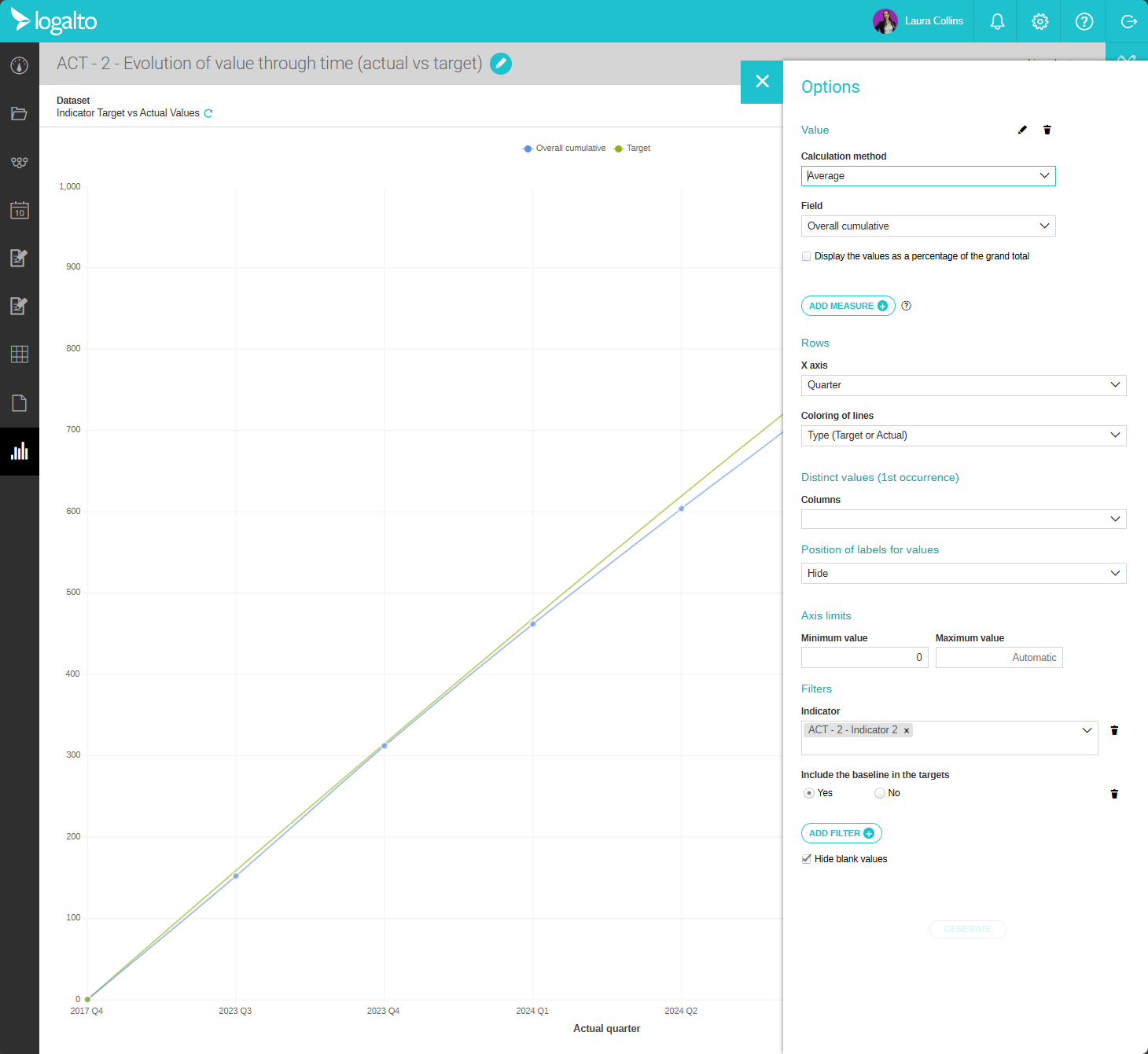Indicator datasets
The logframe module allows you to create indicators and enter their actuals in the indicator tracking table. The table calculates the rate of the actuals on their targets and even provides quick charts to visualize indicator data. However, if you want to create your own visuals, or export data out of LogAlto, you have to interact with the datasets provided. When it comes to indicators, you have to choose among three datasets:
Indicator Values
This dataset has been carefully organized to make it easier to access the overview of all indicator values. In practical terms, this implies that you will not be provided with disaggregated values. Instead, you will only have access to the values that are readily visible in the indicator tracking table.

When you are working with this dataset, you must keep in mind the following:
- The dataset contains all combinations of actuals and targets. This means that if you have three (3) targets for an indicator, an actual for a specific period will appear on three (3) lines.
- If an indicator is a corporate or global indicator and is used in your project, the dataset will contain the version for each logframe (project and global).
This is why you may have to use the following attributes (or "flags"):
Is Last actualIs last or empty targetIs ProjectandIs Global
For example: In the screenshot above, for Indicator 1, we see values entered for 2 periods, and three cumulative targets (35, 45, and 75).
The screenshot below shows the Indicator Values dataset.

If I want to retrieve the rate of the latest cumulative value on the final target, I make sure filters are set for both the Is Last Actual flag and the Is Last or Empty Target flag. This selects the last actual on the final target, where you can find the rate of 46.67%.
If I wanted the rate for any other target, for example the last quarter with an actual, then I would use the Is Last Actual filter and filter on the Target Date to match that of the Actual Date . Here, I would find the rate of 77.78% (for 2024 Q4).
Indicator Disaggregated Values
This dataset provides access to all of the disaggregated indicator values. This is the dataset you require for a more detailed breakdown of your indicators.

When you are working with this dataset, you must keep in mind the following:
- The dataset only contains the final disaggregated targets. Therefore, you will not find the
Is last or empty targetflag nor theTarget dateattribute. - The dataset contains the disaggregated baseline values under the
Overall cumulativeattribute, which you may select with the correspondingActual date. - Just as with the previous dataset, aggregate values of corporate indicators (global logframes) are shown alongside the project-specific values.
- References to all categories of your disaggregation are found under the attributes
Disaggregation item #, where the number represents the number of disaggregation lists (in the case of indicators with two disaggregation lists, there will be values under item 1 and 2). - You may also find the reference to the category of disaggregation under an attribute named after the list. For example, if an indicator is disaggregated by Gender, there will be an attribute named
Gender. - Corporate indicators always have a disaggregation for Project.

This is why you may have to use the following attributes (or "flags"):
Is Last actualIs ProjectandIs GlobalIs global and project (disaggregation) only
The first flags act the same way as for the Indicator Values dataset. The last flag is specific to this dataset. Take, for example, the previous indicator as seen for a specific period in the global logframe. You will notice that the values are attributed to a specific project.

If you want, for instance, to obtain all values for this corporate indicator per project, you should apply the Is global and project (disaggregation) only flag.

Indicator Target vs Actual Values
This dataset is designed to facilitate the production of charts comparing cumulative values to targets. When working with this dataset, it is important to keep the following in mind:
- The dataset does not contain the rate of the indicator.
- The dataset only includes the overall cumulative values and the targets.
- Values are not disaggregated.
For instance, let's consider a specific scenario to illustrate this point. Here is a screenshot displaying the history panel of a single indicator, showing the progress, cumulative values, and rate for each reported period.

When you select this dataset, the data is stored as follows:

Given that all values are contained within a single column for each row, and the attribute or type is situated in a distinct column, it becomes convenient to generate a chart. This can be achieved by choosing Overall cumulative as the designated value field, and Type (Target or Actual) as the dimension.

It's important to observe that the baseline value, represented by the '0's in the screenshot, serves as both an overall cumulative and as a target. This dual presence provides flexibility and allows for customizable visualization in Analytics. You have the option to decide whether to incorporate or exclude the baseline as a target, which impacts the starting point of the line chart.
The datasets in this article offer much more data than shown here, including additional insights on indicator settings, projects, the Logframe, and the Indicator Library. Reviewing the full dataset in a standard table format is recommended for a thorough understanding before creating your own charts. Starting with a quick chart will also show you how they are configured.
